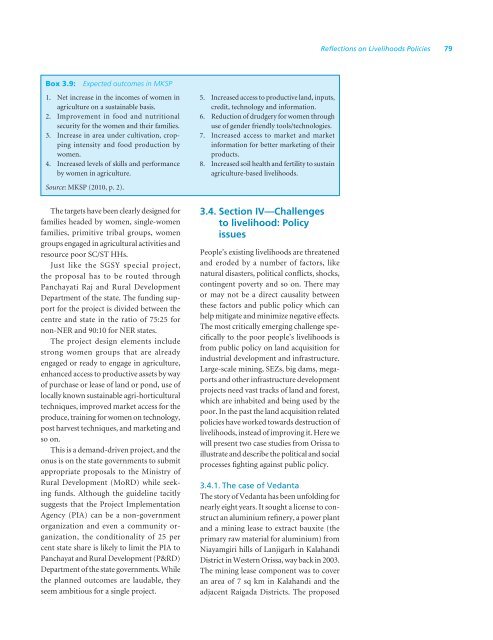SOIL Report 2011 - ACCESS Development Services
SOIL Report 2011 - ACCESS Development Services
SOIL Report 2011 - ACCESS Development Services
- No tags were found...
Create successful ePaper yourself
Turn your PDF publications into a flip-book with our unique Google optimized e-Paper software.
Reflections on Livelihoods Policies 79Box 3.9: Expected outcomes in MKSP1. Net increase in the incomes of women inagriculture on a sustainable basis.2. Improvement in food and nutritionalsecurity for the women and their families.3. Increase in area under cultivation, croppingintensity and food production bywomen.4. Increased levels of skills and performanceby women in agriculture.Source: MKSP (2010, p. 2).5. Increased access to productive land, inputs,credit, technology and information.6. Reduction of drudgery for women throughuse of gender friendly tools/technologies.7. Increased access to market and marketinformation for better marketing of theirproducts.8. Increased soil health and fertility to sustainagriculture-based livelihoods.The targets have been clearly designed forfamilies headed by women, single-womenfamilies, primitive tribal groups, womengroups engaged in agricultural activities andresource poor SC/ST HHs.Just like the SGSY special project,the proposal has to be routed throughPanchayati Raj and Rural <strong>Development</strong>Department of the state. The funding supportfor the project is divided between thecentre and state in the ratio of 75:25 fornon-NER and 90:10 for NER states.The project design elements includestrong women groups that are alreadyengaged or ready to engage in agriculture,enhanced access to productive assets by wayof purchase or lease of land or pond, use oflocally known sustainable agri-horticulturaltechniques, improved market access for theproduce, training for women on technology,post harvest techniques, and marketing andso on.This is a demand-driven project, and theonus is on the state governments to submitappropriate proposals to the Ministry ofRural <strong>Development</strong> (MoRD) while seekingfunds. Although the guideline tacitlysuggests that the Project ImplementationAgency (PIA) can be a non-governmentorganization and even a community organization,the conditionality of 25 percent state share is likely to limit the PIA toPanchayat and Rural <strong>Development</strong> (P&RD)Department of the state governments. Whilethe planned outcomes are laudable, theyseem ambitious for a single project.3.4. Section IV—Challengesto livelihood: PolicyissuesPeople’s existing livelihoods are threatenedand eroded by a number of factors, likenatural disasters, political conflicts, shocks,contingent poverty and so on. There mayor may not be a direct causality betweenthese factors and public policy which canhelp mitigate and minimize negative effects.The most critically emerging challenge specificallyto the poor people’s livelihoods isfrom public policy on land acquisition forindustrial development and infrastructure.Large-scale mining, SEZs, big dams, megaportsand other infrastructure developmentprojects need vast tracks of land and forest,which are inhabited and being used by thepoor. In the past the land acquisition relatedpolicies have worked towards destruction oflivelihoods, instead of improving it. Here wewill present two case studies from Orissa toillustrate and describe the political and socialprocesses fighting against public policy.3.4.1. The case of VedantaThe story of Vedanta has been unfolding fornearly eight years. It sought a license to constructan aluminium refinery, a power plantand a mining lease to extract bauxite (theprimary raw material for aluminium) fromNiayamgiri hills of Lanjigarh in KalahandiDistrict in Western Orissa, way back in 2003.The mining lease component was to coveran area of 7 sq km in Kalahandi and theadjacent Raigada Districts. The proposed














